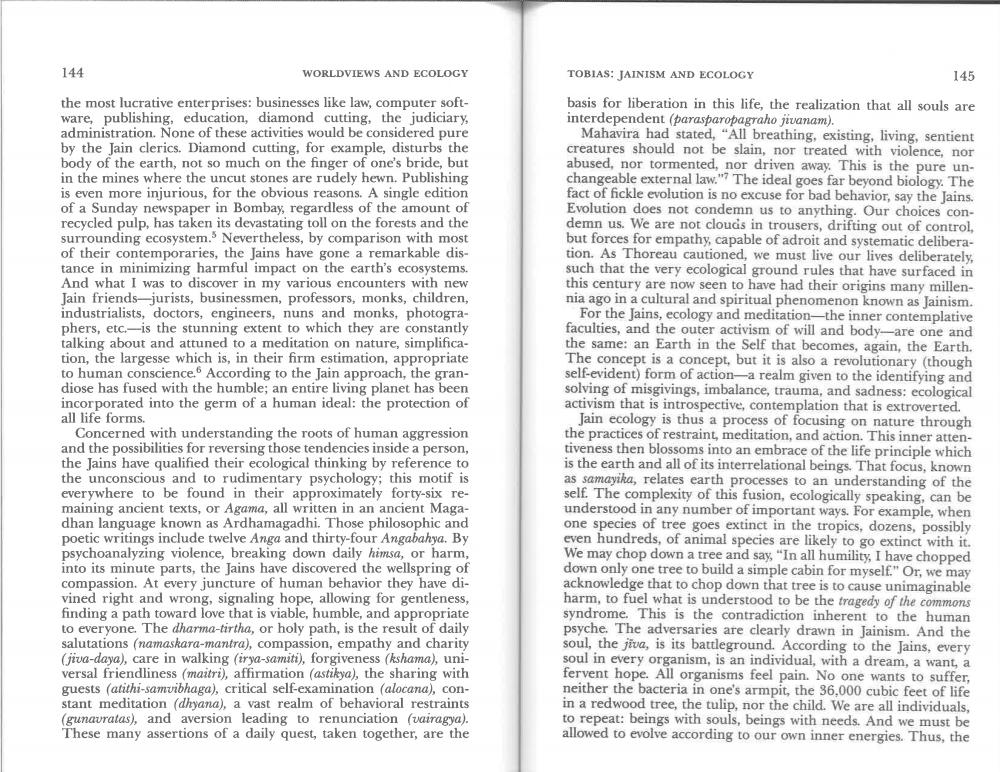Book Title: Jainism and Ecology Views of Nature Nonviolence and Vegeteranism Author(s): Michael Tobias Publisher: Michael Tobias View full book textPage 4
________________ 144 WORLDVIEWS AND ECOLOGY TOBIAS: JAINISM AND ECOLOGY 145 the most lucrative enterprises: businesses like law, computer software, publishing, education, diamond cutting, the judiciary, administration. None of these activities would be considered pure by the Jain clerics. Diamond cutting, for example, disturbs the body of the earth, not so much on the finger of one's bride, but in the mines where the uncut stones are rudely hewn. Publishing is even more injurious, for the obvious reasons. A single edition of a Sunday newspaper in Bombay, regardless of the amount of recycled pulp, has taken its devastating toll on the forests and the surrounding ecosystem. Nevertheless, by comparison with most of their contemporaries, the Jains have gone a remarkable distance in minimizing harmful impact on the earth's ecosystems. And what I was to discover in my various encounters with new Jain friends-jurists, businessmen, professors, monks, children, industrialists, doctors, engineers, nuns and monks, photographers, etc.-is the stunning extent to which they are constantly talking about and attuned to a meditation on nature, simplification, the largesse which is, in their firm estimation, appropriate to human conscience. According to the Jain approach, the grandiose has fused with the humble; an entire living planet has been incorporated into the germ of a human ideal: the protection of all life forms. Concerned with understanding the roots of human aggression and the possibilities for reversing those tendencies inside a person, the Jains have qualified their ecological thinking by reference to the unconscious and to rudimentary psychology; this motif is everywhere to be found in their approximately forty-six remaining ancient texts, or Agama, all written in an ancient Magadhan language known as Ardhamagadhi. Those philosophic and poetic writings include twelve Anga and thirty-four Angabahya. By psychoanalyzing violence, breaking down daily himsa, or harm, into its minute parts, the Jains have discovered the wellspring of compassion. At every juncture of human behavior they have divined right and wrong, signaling hope, allowing for gentleness, finding a path toward love that is viable, humble, and appropriate to everyone. The dharma-tirtha, or holy path, is the result of daily salutations (namaskara-mantra), compassion, empathy and charity (jiva-daya), care in walking (irya-samiti), forgiveness (kshama), universal friendliness (maitri), affirmation (astikya), the sharing with guests (atithi-samvibhaga), critical self-examination (alocana), constant meditation (dhyana), a vast realm of behavioral restraints (gunavratas), and aversion leading to renunciation (vairagya). These many assertions of a daily quest, taken together, are the basis for liberation in this life, the realization that all souls are interdependent (parasparopagraho jivanam). Mahavira had stated, "All breathing, existing, living, sentient creatures should not be slain, nor treated with violence, nor abused, nor tormented, nor driven away. This is the pure unchangeable external law." The ideal goes far beyond biology. The fact of fickle evolution is no excuse for bad behavior, say the Jains. Evolution does not condemn us to anything. Our choices condemn us. We are not clouds in trousers, drifting out of control, but forces for empathy, capable of adroit and systematic deliberation. As Thoreau cautioned, we must live our lives deliberately, such that the very ecological ground rules that have surfaced in this century are now seen to have had their origins many millennia ago in a cultural and spiritual phenomenon known as Jainism. For the Jains, ecology and meditation the inner contemplative faculties, and the outer activism of will and body--are one and the same: an Earth in the Self that becomes, again, the Earth. The concept is a concept, but it is also a revolutionary (though self-evident) form of action-a realm given to the identifying and solving of misgivings, imbalance, trauma, and sadness: ecological activism that is introspective, contemplation that is extroverted. Jain ecology is thus a process of focusing on nature through the practices of restraint, meditation, and action. This inner attentiveness then blossoms into an embrace of the life principle which is the earth and all of its interrelational beings. That focus, known as samayika, relates earth processes to an understanding of the self. The complexity of this fusion, ecologically speaking, can be understood in any number of important ways. For example, when one species of tree goes extinct in the tropics, dozens, possibly even hundreds of animal species are likely to go extinct with it. We may chop down a tree and say, "In all humility, I have chopped down only one tree to build a simple cabin for myself." Or, we may acknowledge that to chop down that tree is to cause unimaginable harm, to fuel what is understood to be the tragedy of the commons syndrome. This is the contradiction inherent to the human psyche. The adversaries are clearly drawn in Jainism. And the soul, the jiva, is its battleground. According to the Jains, every soul in every organism, is an individual, with a dream, a want, a fervent hope. All organisms feel pain. No one wants to suffer, neither the bacteria in one's armpit, the 36,000 cubic feet of life in a redwood tree, the tulip, nor the child. We are all individuals, to repeat: beings with souls, beings with needs. And we must be allowed to evolve according to our own inner energies. Thus, thePage Navigation
1 2 3 4 5 6
